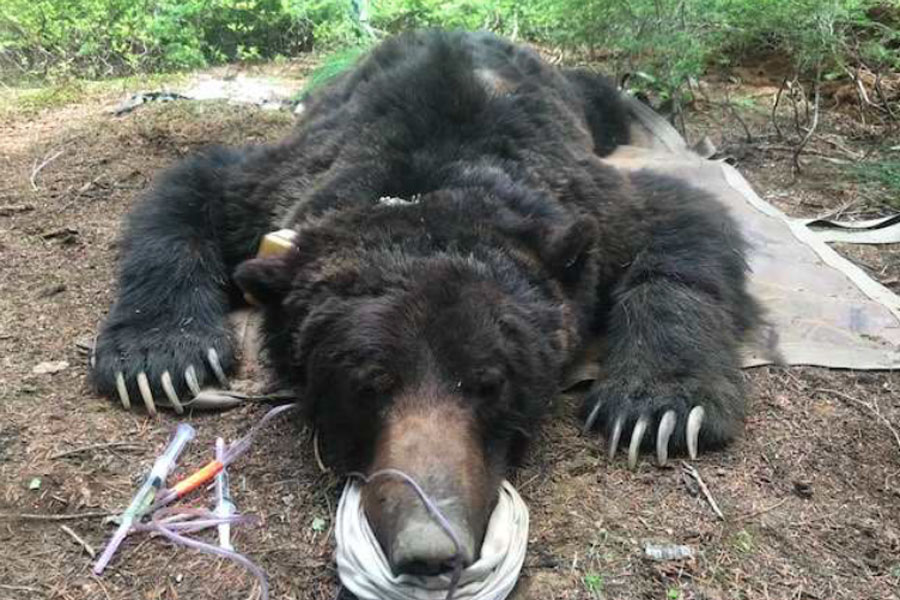Recent reports of Montana grizzly bears in Idaho and Washington show that bruins from the Big Sky are literally pushing boundaries.
According to Wayne Kasworm, the U.S. Fish and Wildlife grizzly manager in Libby, a 2-year-old, 476-pound male grizzly bear initially captured in the Selkirk Mountains wandered west of the Pend Oreille River and into Washington state last month.
The grizzly was originally captured near Rathdrum, Idaho and relocated to the Cabinet Mountains, but has recently been using habitat on the periphery of the Selkirk Mountains north of Bonners Ferry. Another 2-year-old grizzly bear originally captured in the Selkirks has moved southeast through the Cabinet-Yaak and recently lost its radio collar in the Fisher River. The bear traveled more than 125 miles from the Selkirks to its most southeasterly point.
“This is another example of bears moving from one recovery area to another,” according to Kasworm, who added that ultimate population linkage is determined by reproduction and gene flow from one population to another, and evidence of reproduction between the different recovery areas has not been documented.
The Cabinet-Yaak and Selkirk recovery areas each hold about 55 grizzly bears in the remote mountains along the Canadian border with Montana, Idaho and Washington. They’re dwarfed by the Northern Continental Divide Ecosystem, which has an estimated 1,000 grizzlies in the mountains between Glacier National Park and Missoula.
Today, thanks largely to an augmentation program that Kasworm helped establish, there is an estimated 55-60 grizzly bears in the Cabinet-Yaak Ecosystem, with a projected growth rate of 2.1 percent annually.
That stands in contrast to the Northern Continental Divide Ecosystem, which holds an estimated 1,000 grizzlies in the mountains between Glacier National Park and Missoula.
Grizzly bears are protected as a threatened species under the federal Endangered Species Act and cannot be hunted in the Lower 48 states.
About 750 grizzlies in the Greater Yellowstone Ecosystem and surrounding Yellowstone National Park. That population was delisted from the Endangered Species Act in 2017, but a federal judge in Missoula reversed the delisting in September.
Under Kasworm’s guidance, the Cabinet-Yaak augmentation program continues to be a success in an ecosystem that saw its grizzly bear population nearly vanish 30 years ago. In 1988, biologists estimated fewer than 15 grizzly bears remained in the Cabinet-Yaak, which spans approximately 1,000 square miles in the Yaak River drainage and 1,620 square miles in the Cabinet Mountains.
So far, the program has introduced 20 grizzlies into the Cabinet-Yaak Ecosystem.
Illustrating the intent and success of the program, the third bear moved through augmentation, a female in 1993, is responsible for at least 25 descendants through three generations. That female produced at least 10 first-generation offspring, which gave rise to at least 14 additional grizzly bears, and among those at least one offspring and counting.
The recovery goal is 100 grizzly bears in the Cabinet-Yaak and hopefully over time the animals will link with surrounding yet separate ecosystems, the Selkirk to the west, the Northern Continental Divide to the east, the Bitterroot to the south, and British Columbia to the north.
Part of the problem for bears increasing gene flow between the recovery areas is that the male grizzlies are moving between the main Cabinet Mountains and the Yaak during the fall rather than in spring, when breeding occurs. Another issue preventing reproduction could be the young bears aren’t yet competitive enough to successfully mate.
Another problem unrelated to reproduction, but which Kasworm noted in a recent report on grizzly bear activity and augmentation, involved a 2-year-old bear released in the West Cabinet Mountains near Spar Lake as part of the augmentation program on July 21. The bear moved south from the release and crossed the Clark Fork River on Aug. 7, according to GPS tracking data from its collar. The bear remained south of the Clark Fork River until Sept. 3, when an Idaho resident reported a collared grizzly bear at a black bear bait site.
On Sept. 5, wildlife managers captured the bear and released it in the South Fork of the Bull River, but the bear returned to the bait site eight days later. Most recently, the bear has been monitored in Montana south and west of Heron
“Baiting of black bears during the black bear hunting season is not allowed in Idaho north of the Clark Fork River nor is it allowed at any time in Montana,” Kasworm said. “The practice of baiting is at contrast with the policy of minimizing attractants for bears until the black bear season opens when these attractants become legal for the purpose of hunting black bears.”
The bait site in this case used human foods and was within 500 yards of five homes and 1,000 yards of more than 20 homes.
According to Kasworm, three grizzly bears are known to have been killed in the area south of the Selkirks and Cabinet-Yaak since 2007. Two of those bears were killed at black bear bait sites.
